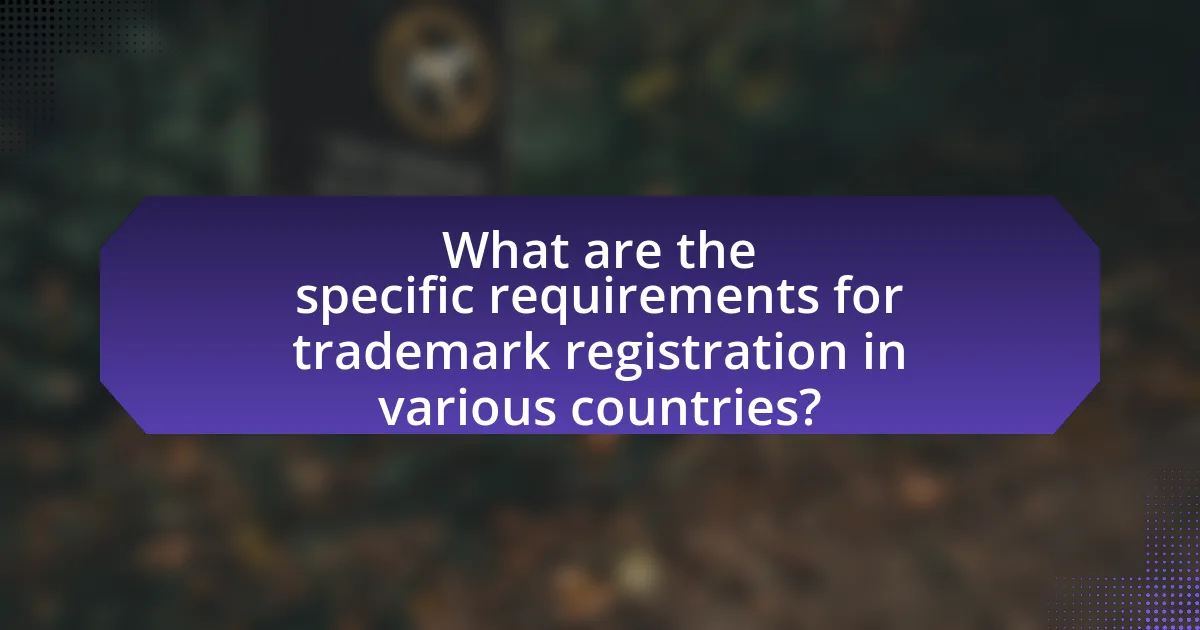The article focuses on the trademark registration process across various countries, detailing the essential steps involved in securing legal protection for a brand’s identity. It outlines the stages of trademark registration, including application submission, examination, publication, opposition, and final registration, while highlighting the differences in procedures and requirements among jurisdictions such as the United States, European Union, and Japan. Additionally, the article discusses the significance of trademark registration for businesses, the legal protections it offers, and the impact of cultural differences on brand identity. It also addresses common challenges faced by applicants and provides best practices for successful registration, emphasizing the importance of thorough research and compliance with local laws.

What is the Trademark Registration Process?
The trademark registration process involves several key steps to secure legal protection for a brand’s identity. Initially, an applicant must conduct a trademark search to ensure that the desired mark is not already in use or registered by another entity. Following this, the applicant files a trademark application with the relevant government authority, such as the United States Patent and Trademark Office (USPTO) in the U.S. This application must include details about the trademark, the goods or services it will represent, and the basis for filing.
Once submitted, the application undergoes examination by a trademark examiner who assesses its compliance with legal requirements. If the application meets all criteria, it is published in an official gazette, allowing third parties to oppose the registration within a specified period. If no opposition is filed, or if any opposition is resolved in favor of the applicant, the trademark is registered, granting the owner exclusive rights to use the mark in commerce.
This process is supported by legal frameworks established in various jurisdictions, such as the Lanham Act in the United States, which outlines the procedures and requirements for trademark registration.
How does the trademark registration process vary across different countries?
The trademark registration process varies significantly across different countries due to differing legal frameworks, requirements, and procedures. For instance, in the United States, the process involves filing an application with the United States Patent and Trademark Office (USPTO), which includes a review of the application for compliance with legal standards and a potential opposition period. In contrast, the European Union employs a centralized system through the European Union Intellectual Property Office (EUIPO), allowing for a single application to cover all member states, which streamlines the process. Additionally, countries like Japan require a formal examination process that can take several months, while others, such as India, have a more expedited process but may involve additional documentation. These variations reflect each country’s approach to intellectual property protection, influenced by local laws, economic conditions, and international treaties.
What are the key stages in the trademark registration process globally?
The key stages in the trademark registration process globally include application submission, examination, publication, opposition, and registration. Initially, an applicant submits a trademark application to the relevant intellectual property office, detailing the trademark and its intended use. Following submission, the application undergoes examination to assess compliance with legal requirements and potential conflicts with existing trademarks. If the application passes examination, it is published in an official gazette, allowing third parties to oppose the registration within a specified period. If no opposition is filed or if opposition is resolved in favor of the applicant, the trademark is officially registered, granting the applicant exclusive rights to use the trademark in connection with the specified goods or services. These stages are consistent across many jurisdictions, although specific procedures and timelines may vary.
How do cultural differences influence trademark registration?
Cultural differences significantly influence trademark registration by affecting the perception of brand identity and the distinctiveness of trademarks in various regions. For instance, in some cultures, certain symbols or colors may carry specific meanings that can either enhance or hinder a trademark’s acceptance. In Japan, for example, the color red is associated with good fortune, which can positively impact a brand’s image, while in other cultures, it may symbolize danger. Additionally, cultural attitudes towards intellectual property can vary; in some countries, there is a strong emphasis on protecting local heritage, which may lead to stricter scrutiny of trademarks that appear to appropriate cultural elements. This is evident in cases where indigenous symbols are registered as trademarks, often leading to legal disputes. Therefore, understanding these cultural nuances is crucial for businesses seeking to navigate the trademark registration process effectively in different countries.
Why is trademark registration important for businesses?
Trademark registration is important for businesses because it provides legal protection for brand identity, preventing unauthorized use by others. This legal safeguard helps businesses establish their brand in the marketplace, enhances consumer trust, and can lead to increased market share. According to the World Intellectual Property Organization, registered trademarks can significantly reduce the risk of infringement disputes, as they serve as a public notice of ownership. Additionally, businesses with registered trademarks can leverage their brand value for licensing opportunities, further enhancing their revenue potential.
What legal protections does trademark registration provide?
Trademark registration provides legal protections that include exclusive rights to use the trademark in commerce, preventing others from using a similar mark that could cause confusion. This exclusivity is enforced through legal action against infringers, allowing the trademark owner to seek remedies such as injunctions and damages. Additionally, registered trademarks can serve as a basis for international protection under treaties like the Madrid Protocol, enhancing the owner’s ability to protect their brand globally. These protections are supported by trademark laws in various jurisdictions, which establish the framework for enforcement and dispute resolution.
How does trademark registration enhance brand value?
Trademark registration enhances brand value by providing legal protection and exclusivity over a brand’s identity. This legal safeguard prevents unauthorized use by competitors, thereby maintaining the brand’s reputation and integrity. According to the World Intellectual Property Organization, registered trademarks can increase a company’s market value by up to 20%, as they signify quality and reliability to consumers. Additionally, trademark registration can facilitate brand recognition and customer loyalty, which are critical components of long-term business success.

What are the specific requirements for trademark registration in various countries?
The specific requirements for trademark registration vary by country but generally include the need for a distinct mark, a clear description of goods or services, and the submission of an application to the relevant trademark office. For example, in the United States, the United States Patent and Trademark Office (USPTO) requires applicants to provide a specimen showing the mark in use, while in the European Union, the European Union Intellectual Property Office (EUIPO) mandates that the mark must be capable of distinguishing goods or services. In Japan, the Japan Patent Office (JPO) requires a detailed description of the trademark and its intended use. These requirements ensure that trademarks are unique and serve their purpose of identifying the source of goods or services.
What documents are typically needed for trademark registration?
To register a trademark, the typical documents required include a completed application form, a representation of the trademark, and proof of use or intent to use the trademark in commerce. The application form must detail the trademark owner’s information and the goods or services associated with the trademark. A clear depiction of the trademark, whether it is a logo, word, or phrase, is essential for identification. Additionally, many jurisdictions require evidence demonstrating that the trademark is being used in the market or a declaration of the intent to use it in the future, which supports the application’s legitimacy.
How do application fees differ by country?
Application fees for trademark registration vary significantly by country, reflecting differences in economic conditions and administrative processes. For instance, in the United States, the application fee ranges from $250 to $350 per class of goods or services, while in the European Union, the fee starts at €850 for one class and increases for additional classes. In contrast, countries like India have a lower fee structure, with costs around ₹4,500 (approximately $60) for individuals and small businesses. These variations are influenced by factors such as the country’s legal framework, the complexity of the registration process, and the level of government support for intellectual property rights.
What are the common grounds for refusal in trademark applications?
Common grounds for refusal in trademark applications include lack of distinctiveness, likelihood of confusion with existing trademarks, descriptiveness, and non-compliance with legal requirements. Lack of distinctiveness occurs when a mark does not sufficiently identify the source of goods or services. Likelihood of confusion arises when a proposed mark is similar to an existing mark, potentially misleading consumers. Descriptiveness refers to marks that merely describe the goods or services, which are not eligible for protection. Non-compliance with legal requirements can involve issues such as improper classification or failure to meet filing deadlines. These grounds are established in trademark law to ensure that trademarks serve their purpose of identifying and distinguishing goods and services in the marketplace.
How do different countries handle trademark opposition and cancellation?
Different countries handle trademark opposition and cancellation through distinct legal frameworks and procedures. In the United States, the opposition process occurs during the publication phase of a trademark application, allowing third parties to file an opposition with the Trademark Trial and Appeal Board within 30 days. In contrast, the European Union employs a similar system where oppositions can be filed within three months of publication, managed by the European Union Intellectual Property Office.
In Japan, opposition can be filed within two months of publication, while cancellation actions can be initiated at any time after registration, based on specific grounds such as non-use. Australia allows for opposition within two months of publication, and cancellation can be pursued based on non-use or other statutory grounds.
These processes reflect each country’s legal approach to protecting trademark rights and balancing the interests of trademark owners and third parties.
What is the process for opposing a trademark application in various jurisdictions?
The process for opposing a trademark application varies by jurisdiction but generally involves filing a formal opposition with the relevant trademark office within a specified period after the application is published for opposition. In the United States, for example, the opposition must be filed with the United States Patent and Trademark Office (USPTO) within 30 days of publication in the Official Gazette, and the opposing party must demonstrate standing and grounds for opposition, such as likelihood of confusion or descriptiveness. In the European Union, the opposition process is similar, requiring submission to the European Union Intellectual Property Office (EUIPO) within three months of publication, with the need to substantiate claims based on earlier rights. In jurisdictions like Canada, the opposition must be filed within two months of the application being published, and the process includes a hearing if the parties do not reach a settlement. Each jurisdiction has specific rules and timelines, making it essential for parties to be aware of local regulations to effectively oppose a trademark application.
How can a trademark be canceled once registered?
A trademark can be canceled once registered by filing a petition for cancellation with the relevant trademark office or authority. This process typically requires demonstrating valid grounds for cancellation, such as non-use of the trademark for a specified period, likelihood of confusion with another mark, or that the trademark was obtained fraudulently. For instance, in the United States, the Trademark Trial and Appeal Board (TTAB) handles cancellation proceedings, and a petitioner must provide evidence supporting their claims, such as proof of prior use of a similar mark or documentation showing the registered mark’s abandonment.

What are the common challenges in the trademark registration process?
The common challenges in the trademark registration process include the likelihood of confusion with existing trademarks, the complexity of international laws, and the potential for opposition from third parties. The likelihood of confusion arises when a new trademark is similar to an already registered one, which can lead to rejection by trademark offices. Additionally, navigating the varying trademark laws across different countries complicates the registration process, as each jurisdiction has its own requirements and procedures. Furthermore, third parties may oppose a trademark application, citing reasons such as prior use or similarity to their own marks, which can delay or prevent registration. These challenges highlight the importance of thorough research and legal guidance in the trademark registration process.
What are the most frequent obstacles faced by applicants?
The most frequent obstacles faced by applicants in the trademark registration process include complex legal requirements, high costs, and lengthy processing times. Applicants often struggle with understanding the specific regulations and documentation needed in different jurisdictions, which can vary significantly. For instance, a study by the World Intellectual Property Organization (WIPO) highlights that 40% of applicants cite confusion over local laws as a major barrier. Additionally, the financial burden associated with application fees and potential legal assistance can deter applicants, with costs sometimes exceeding several thousand dollars. Furthermore, the average processing time for trademark applications can range from several months to years, leading to frustration and delays in brand protection.
How can applicants overcome these challenges?
Applicants can overcome challenges in the trademark registration process by conducting thorough research on the specific requirements of each country. Understanding local laws, regulations, and procedures is crucial, as these can vary significantly. For instance, the World Intellectual Property Organization (WIPO) provides resources and guidelines that detail the trademark registration process in various jurisdictions, helping applicants navigate complexities. Additionally, seeking assistance from local legal experts or trademark attorneys can provide tailored advice and support, ensuring compliance with local practices and increasing the likelihood of successful registration.
What role do trademark attorneys play in navigating these challenges?
Trademark attorneys play a crucial role in navigating the challenges of the trademark registration process across different countries. They provide expert guidance on the specific legal requirements and procedures necessary for successful registration in various jurisdictions. For instance, trademark attorneys help clients conduct comprehensive trademark searches to identify potential conflicts with existing marks, which is essential for avoiding legal disputes. Additionally, they assist in preparing and filing trademark applications, ensuring compliance with local laws and regulations, which can vary significantly from one country to another. Their expertise also extends to advising on international treaties, such as the Madrid Protocol, which facilitates the registration of trademarks in multiple countries through a single application. This specialized knowledge is vital for businesses seeking to protect their intellectual property globally, as it minimizes the risk of rejection or infringement.
What best practices should applicants follow for successful trademark registration?
Applicants should conduct thorough research on existing trademarks before filing for registration to ensure their mark is unique and not infringing on others. This involves searching trademark databases, such as the United States Patent and Trademark Office (USPTO) database, to identify potential conflicts. Additionally, applicants should clearly define the goods or services associated with their trademark, as specificity can enhance the likelihood of approval. Proper classification according to the Nice Classification system is essential for accurate registration.
Furthermore, applicants should prepare a comprehensive application that includes all required information and documentation, as incomplete submissions can lead to delays or rejections. Engaging a trademark attorney can provide valuable guidance throughout the process, increasing the chances of successful registration. According to the USPTO, applications that are well-prepared and complete have a significantly higher approval rate.
How can thorough research improve the chances of successful registration?
Thorough research can significantly improve the chances of successful registration by ensuring that applicants understand the specific requirements and potential obstacles of the trademark registration process in different countries. By analyzing existing trademarks, applicants can identify potential conflicts and assess the uniqueness of their mark, which is crucial for avoiding rejections. For instance, a study by the World Intellectual Property Organization (WIPO) indicates that conducting a comprehensive trademark search prior to application can reduce the likelihood of opposition and increase approval rates. This proactive approach allows applicants to tailor their submissions to meet local regulations and cultural considerations, further enhancing the likelihood of successful registration.
What strategies can be employed to ensure compliance with local laws?
To ensure compliance with local laws, businesses should implement a comprehensive legal compliance program that includes regular training, audits, and consultation with local legal experts. This program should be tailored to the specific legal requirements of each jurisdiction where the business operates, as laws can vary significantly between countries. For instance, a study by the International Compliance Association highlights that organizations with structured compliance programs are 50% more likely to avoid legal penalties. Additionally, maintaining up-to-date knowledge of local regulations through continuous monitoring and engaging with local authorities can further enhance compliance efforts.
What resources are available for understanding trademark registration in different countries?
Resources for understanding trademark registration in different countries include government websites, international organizations, and legal databases. Government websites, such as the United States Patent and Trademark Office (USPTO) and the European Union Intellectual Property Office (EUIPO), provide specific guidelines and procedures for trademark registration in their respective jurisdictions. International organizations like the World Intellectual Property Organization (WIPO) offer comprehensive resources, including treaties and databases, that facilitate understanding of trademark laws across multiple countries. Additionally, legal databases such as LexisNexis and Westlaw contain case law, statutes, and articles that provide insights into trademark registration processes globally. These resources collectively ensure that individuals and businesses can navigate the complexities of trademark registration effectively.



